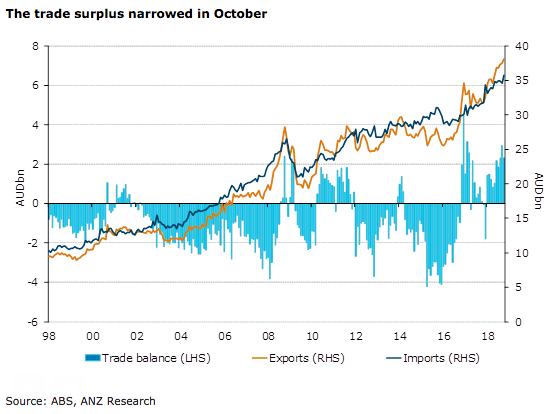Australia’s trade balance for the month of October deteriorated, owing to improvements in imports of capital goods and intermediate goods, which is consistent with the solid pipeline of business investment and government infrastructure projects. Export growth was supported by a large increase the value of coal exports.
The monthly trade balance deteriorated to a surplus of AUD2,316 million in October. September’s surplus was revised slightly lower to AUD2,940 million (from AUD3,017 million). October’s change reflects a 3.2 percent m/m increase in imports and a 1.3 percent increase in exports.
Total export values were up 20 percent y/y. Resource exports were up 2.5 percent m/m, led by a 12.5 percent surge in coal, while other mineral fuels rose 4.1 percent and metal ores and minerals fell 0.6 percent.
Manufactured goods rose 5.4 percent, with machinery up 3.7 percent. Rural goods fell, likely reflecting the impact of the eastern drought, with cereals and grains down 15.4 percent. Service exports rose 1.1 percent as freight transport increased 8.7 percent and travel rose 2.3 percent.
Total imports rose 13 percent y/y. Intermediate and other merchandise was the largest contributor to the monthly rise, up 4.8 percent m/m. Within this, fuel and lubricants rose 11 percent.
Meanwhile, capital goods increased 7.8 percent, with telecommunications equipment rising 12.6 percent and machinery and equipment increasing 5.6 percent. Consumption goods rose 1.2 percent, with textiles, clothing and footwear up 4.7 percent and household electrical items up 1.9 percent. Service imports fell 0.3 percent, with travel falling at the same rate.



 New Zealand Business Confidence Hits 30-Year High as Economic Outlook Improves
New Zealand Business Confidence Hits 30-Year High as Economic Outlook Improves  Austan Goolsbee Signals Potential for More Fed Rate Cuts as Inflation Shows Improvement
Austan Goolsbee Signals Potential for More Fed Rate Cuts as Inflation Shows Improvement  Gold Prices Fall Amid Rate Jitters; Copper Steady as China Stimulus Eyed
Gold Prices Fall Amid Rate Jitters; Copper Steady as China Stimulus Eyed  Asian Fund Managers Turn More Optimistic on Growth but Curb Equity Return Expectations: BofA Survey
Asian Fund Managers Turn More Optimistic on Growth but Curb Equity Return Expectations: BofA Survey  Trump Orders Blockade of Sanctioned Oil Tankers, Raising Venezuela Tensions and Oil Prices
Trump Orders Blockade of Sanctioned Oil Tankers, Raising Venezuela Tensions and Oil Prices  FxWirePro: Daily Commodity Tracker - 21st March, 2022
FxWirePro: Daily Commodity Tracker - 21st March, 2022  Singapore Growth Outlook Brightens for 2025 as Economists Flag AI and Geopolitical Risks
Singapore Growth Outlook Brightens for 2025 as Economists Flag AI and Geopolitical Risks  Asian Stocks Slide as AI Spending Fears and Global Central Bank Decisions Weigh on Markets
Asian Stocks Slide as AI Spending Fears and Global Central Bank Decisions Weigh on Markets 































